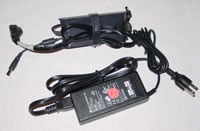Asus Z80K: Athlon 64 DTR Notebook
Construction: Field Tested
|
Charger – The charger for the Z80K is an average size unit. It can be compared to the size of the charger for Dell notebooks, although it is just a tad larger. Since the power port is on the side of the notebook, the charger has an angled power plug. The best design is to have the power port on the back side of the notebook with a straight power plug.
Display – Asus chose a 15.0" SXGA+ widescreen display that is capable of a native 1400 x 1050 resolution with 16 brightness settings. The highest two settings (16 and 15) are hard to distinguish between, but at the lowest setting, the dimness of the notebook is still enough to use in a dark room but it will get to be a strain on the eyes quickly. One step up from the lowest setting makes a huge difference, and it should be ok to use. At its brightest setting on AC, the display has a natural feel and looks great. On battery power, the brightest setting is a tad dimmer, but there isn't a large enough difference to worry about.
Fan - Just about all fans on current and reasonably current notebooks use a variable speed design, which allow for low speed on low CPU usage/heat and vice versa. The heatsink on the Z80K is probably one of the smallest in the desktop replacement (DTR) category, but this doesn't make it any less effective. It is pretty close to the noise of two 80mm x 80mm case fans on max, but rarely does it reach this volume level. In a quiet room, you would have to be within a foot to hear the fan on its lowest setting.
Heat – With desktop replacement notebooks, heat is a major issue. Temperatures basically mimic a desktop computer, since desktop components are used in this notebook. Even though the CPU used in this notebook is classified as "mobile" by AMD, there isn't an architectural difference between AMD's mobile and desktop Athlon 64s, like there is between Intel's desktop Pentium 4s and mobile Pentium M CPUs. AMD's mobile Athlon 64 line at the moment is more comparable to the difference between a higher clocked and a slightly lower clocked CPU in the same family, minus a few minor tweaks that AMD enables to eek out more battery life.
Since Asus uses an extensive cooling system, the heat is spread out more than just centralized in a single place. This is the trend we are seeing with just about all DTRs in the past year and a half. The heat, though, is mainly felt on the underside where the hard drive, CPU, and WiFi card/optical drive are located. In all, the top side stays fairly cool unless you remove the top bezel to access the components below the keyboard, in which case the memory, WiFi card, and video card get toasty.







